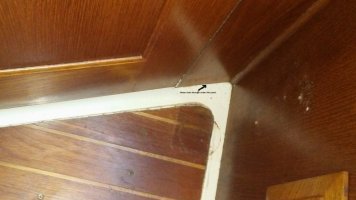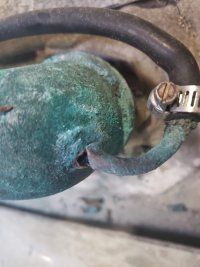bsangs
E35-3 - New Jersey
After a mostly uneventful summer of sailing, I've come across an aggravating development. (I will post photos of this later, as I haven't taken any good ones yet.)
I always make sure the bilge is dry before we head out, and have no problem doing the taste test. For instance, I realize the fresh water is present after it rains, due to the mast, and I know the small amount of brackish water I get in the most aft part of the bilge is due to that tiny dust bin keel bolt leaking. However, after the last couple sails - which have involved quite a bit of motoring for lack of wind - we've come back to find about an inch of the brackish water in the four main bilge compartments, and I've no idea why. The water does not have any diesel/oil taste or color to it, just the usual Hudson River look and taste.
There is no visible water trail from rear of the bilge, from the sides, or from the front. The galley seacocks and hoses are not leaking, and that area is dry. Under the engine is damp, but when I look at the shaft it appears bone dry. I see some visible rusty looking water marks to the rear of the shaft, under the exchanger, but it doesn't appear to be much. It's as if this water is coming into the bilge from below. I've yet to go completely down into the engine area from behind, but realize that's the next step. If we're lucky enough to get out again before having everything winterized, I plan to go down below and watch what happens while my wife takes the helm. (The wife that says, "Stop obsessing. It's a boat bilge. They get water in them." )
)
I've read countless bilge posts on these forums, but am still stumped. Any advice or suggestions from the longtime Ericson owners? Thanks in advance.
I always make sure the bilge is dry before we head out, and have no problem doing the taste test. For instance, I realize the fresh water is present after it rains, due to the mast, and I know the small amount of brackish water I get in the most aft part of the bilge is due to that tiny dust bin keel bolt leaking. However, after the last couple sails - which have involved quite a bit of motoring for lack of wind - we've come back to find about an inch of the brackish water in the four main bilge compartments, and I've no idea why. The water does not have any diesel/oil taste or color to it, just the usual Hudson River look and taste.
There is no visible water trail from rear of the bilge, from the sides, or from the front. The galley seacocks and hoses are not leaking, and that area is dry. Under the engine is damp, but when I look at the shaft it appears bone dry. I see some visible rusty looking water marks to the rear of the shaft, under the exchanger, but it doesn't appear to be much. It's as if this water is coming into the bilge from below. I've yet to go completely down into the engine area from behind, but realize that's the next step. If we're lucky enough to get out again before having everything winterized, I plan to go down below and watch what happens while my wife takes the helm. (The wife that says, "Stop obsessing. It's a boat bilge. They get water in them."
I've read countless bilge posts on these forums, but am still stumped. Any advice or suggestions from the longtime Ericson owners? Thanks in advance.






